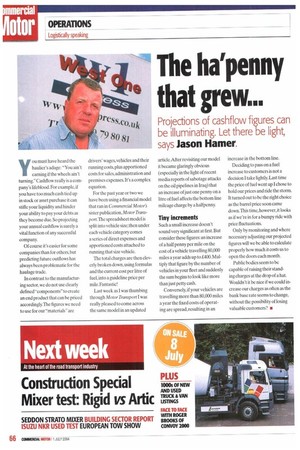The ha'penny that grew...
Page 66

If you've noticed an error in this article please click here to report it so we can fix it.
Projections of cashflow figures can be illuminating. Let there be light,
says Jason Hamer.
you must have heard the haulier's adage: "You ain't earning if the wheels ain't turning." Cashflow really is a company's lifeblood. For example, if you have too much cash tied up in stock or asset purchase it can stifle your liquidity and hinder your ability to pay your debts as they become due. So projecting your annual cashflow is surely a vital function of any successful company.
Of course it's easier for some companies than for others, but predicting future outflows has always been problematic for the haulage trade.
In contrast to the manufacturing sector, we do not use clearly defined "components" to create an end product that can be priced accordingly.The figures we need to use for our "materials" are drivers' wages, vehicles and their running costs, plus apportioned costs for sales, administration and premises expenses. It's a complex equation.
For the past year or two we have been using a financial model that ran in Commercial Motor's sister publication, Motor Tramport. The spreadsheet model is split into vehicle size; then under each vehicle category comes a series of direct expenses and apportioned costs attached to running that size vehicle.
The total charges are then cleverly broken down, using formulas and the current cost per litre of fuel, into a guideline price per mile. Fantastic!
Last week as! was thumbing through Motor Transport I was really pleased to come across the same model in an updated article. After revisiting our model it became glaringly obvious (especially in the light of recent media reports of sabotage attacks on the oil pipelines in Iraq) that an increase ofjust one penny on a litre of fuel affects the bottom line mileage charge by a halfpenny.
Tiny increments
Such a small increase doesn't sound very significant at first. But consider these figures: an increase of a half penny per mile on the cost of a vehicle travelling 80,000 miles a year adds up to 1400. Multiply that figure by the number of vehicles in your fleet and suddenly the sum begins to look like more than just petty cash.
Conversely, if your vehicles are travelling more than 80,000 miles a year the fixed costs of operating are spread, resulting in an increase in the bottom line.
Deciding to pass on a fuel increase to customers is not a decision! take lightly. Last time the price of fuel went up I chose to hold our prices and ride the storm. It turned out to be the right choice as the barrel price soon came down.This time, however, it looks as if we're in for a bumpy ride with price fluctuations.
Only by monitoring and where necessary adjusting our projected figures will we be able to calculate properly how much it costs us to open the doors each month.
Public bodies seem to be capable of raising their standing charges at the drop of a hat. Wouldn't it be nice if we could increase our charges as often as the bank base rate seems to change, without the possibility of losing valuable customers? •


































































































































































































